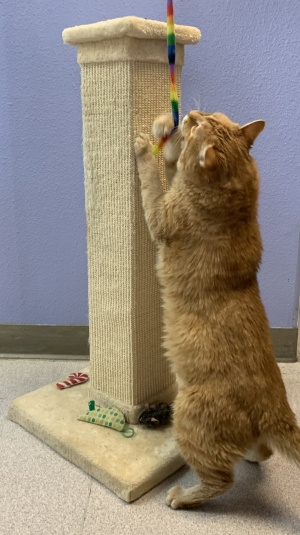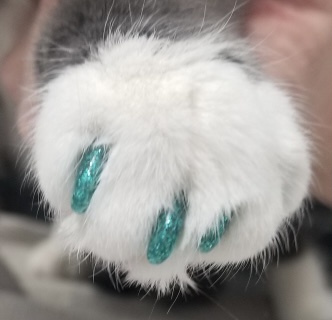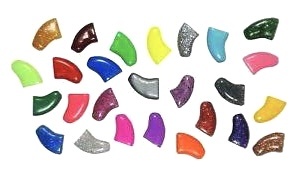Preventative Care for a Healthy Cat
Before Introducing A New Cat To Your Household
We recommend that your new kitty have an examination at The Cat Doctor to pinpoint any health problems. Please consider the following:
- All cats should be tested for Feline Leukemia Virus (FeLV) and Feline Immunodeficiency Virus (FIV, Feline Aids Virus).
- Treat flea infestations immediately. Cheristin, Advantage, or Revolution are all once-a-month topical treatments that eliminate fleas within 24 to 48 hours of application and are very safe.
- Bring in a fresh fecal sample (no more than 6 hours old) for an intestinal parasite check.
If you have other cats, immediately isolate the newcomer to a separate area with its own litter box for 7 to 10 days (or as long as the doctor advises) to prevent spreading infectious diseases and intestinal parasites to other cats in the house.
Intestinal Parasites
“Worms” are common even in cats that appear healthy. The Cat Doctor recommends microscopic stool analysis tests looking for five different intestinal parasites. Stool samples should be no more than six hours old. Litter adhering to the stool sample will not interfere with a basic stool analysis test.
- All recent additions to your cat household should have a stool analysis.
- Cats going outdoors or cats that live with toddler-aged children should have stool samples checked annually.
- All kittens and stray cats should be automatically treated for roundworms (ascarids). Studies show that up to 90% of cats are infected as neonates. Automatic treatment is important because roundworm eggs are intermittently shed in the feces and may escape the detection of routine stool analysis. Cats that share a litter box with the new cat should be treated as well.
- Tapeworms are typically diagnosed by the naked eye. Tapeworms resemble ‘rice segments’ or ‘sesame seeds’ on your cat’s rear end, the surface of the stool, or your cat’s bedding. In our region, fleas are the major intermediate host for tapeworms and the major source of spread. Flea infestations must be controlled or tapeworms can recur. Hunting cats can also pick up tapeworms by eating their prey. Direct cat-to-cat transmission of tapeworms does not occur.
The Retro Viruses: FeLV & FIV
Feline Leukemia Virus (FeLV) and Feline Immunodeficiency Virus (FIV, Feline Aids Virus) are the two most common infectious diseases of cats.
All untested cats should be tested for FeLV and FIV.
- Our in-house screening test requires a small amount of blood and takes about 15 minutes.
- Cats that are recently infected with FeLV may be incubating the virus when tested and may have false-negative test results. Accordingly, all cats that are new to the household should have a second FeLV/FIV test 2 months after their first test. For kittens, the spay/neuter appointment is a convenient time for the second FeLV/FIV test – if they received their first FeLV/FIV test at least 2 months earlier.
- Cats going outdoors who are at greater risk of infection because of fighting and other social behaviors should have annual FeLV/FIV tests.
Feline Leukemia Virus
Depending upon the region of the country we live in, 4 to 7% of cats are infected with Feline Leukemia Virus. The virus is found primarily in the saliva of cats and to a lesser extent in the urine and feces. Spread between cats is usually associated with prolonged and close contact between cats, especially where affectionate licking and grooming occurs. Indirect exposures through contaminated food and water dishes and litter boxes may contribute to transmission. Biting is an infrequent mode of transmission. The majority of kittens and young cats infected with FeLV contract the virus from their mother. The period between infection and development of signs of disease is variable. Cats may live many years before being sickened by the virus. A variety of ailments are caused by FeLV including some cancers, anemia and other bone marrow diseases, reproductive problems and immune suppression leading to chronic or life-threatening conditions.
A special note, the National Cancer Institute recommends that children, pregnant women, elderly persons, cancer patients and individuals with immune systems not be exposed to FeLV positive cats. This is only a precaution. Exhaustive studies have found no evidence that FeLV infects people.
Feline Immunodeficiency Virus
Feline Immunodeficiency Virus is more common in roaming outdoor cats with a propensity for fighting. Biting is the primary mode of virus transmission. The typical FIV positive cat is the tough battle-scarred tomcat. A significant percentage of sick cats test positive for FIV.
Following infection, FIV can remain dormant for years before depressing the immune system and causing a wide variety of chronic and/or fatal diseases. However, many cats that have FIV virus never have FIV-related health problems and often live a normal lifespan. FIV does not infect people.
In kittens younger than 6 months, maternally derived antibodies to FIV can cause false positive FIV test results. Most kittens that test FIV positive under these circumstances are not infected with FIV. When retested, most of these kittens will test FIV negative by 6 months of age.
Annual Health Examinations
Annual health examinations are critical to ensuring your cat will lead a quality life. Yearly health examinations can alert you to hidden medical conditions such as heart disease and dental problems, and can provide peace of mind regarding your cat’s health. At The Cat Doctor we obtain a detailed medical history and perform a thorough physical examination. We often recommend additional tests for cats with suspected medical conditions. Routine screening tests are recommended for senior cats even when they appear healthy.
Remember that cats can’t always tell us when something is wrong. Many diseases start with no obvious signs and progress slowly even when your cat appears healthy. This is especially true in older cats that slow down naturally with advancing age. If the average life span of an indoor cat is 15 years, then cats age five human years for each actual year of their life. A lot can happen in five years, relatively speaking.
Vaccinating Your Cat
Vaccinations are important preventative health measures. Which vaccinations we choose to give depends upon your cat’s living conditions and exposure to other cats and animals.
Your cat’s annual examination email reminder will inform you if vaccinations are due. There will be years when your cat will need only an examination and no vaccinations.
The Cat Doctor requires that all cats have an annual health examination before receiving vaccinations.
Concern about injection-induced tumors has caused a rethinking of vaccination protocols by the veterinary community. Central to this new awareness is that vaccines be given only when cats are at risk for that disease. Further, we now know that some vaccines previously boosted yearly provide protection beyond one year. The Cat Doctor’s vaccination recommendations are based on the most recent guidelines set forth by the American Association of Feline Practitioners (AAFP) and sanctioned by the American Veterinary Medical Association (AVMA).
According to AAFP guidelines, The Cat Doctor only administers core vaccines on a routine basis. The core vaccinations are FVRCP, Rabies and FeLV. Per AAFP guidelines, vaccines containing chlamydia, feline infectious peritonitis (FIP), microsporum, bordetella, ringworm, and giardia are not core vaccines and their use is reserved for special situations.
Owners should monitor all injection sites following shots. At The Cat Doctor vaccinations are given in the right front leg and right and left rear legs. Occasionally, a small lump will form under the skin where a vaccination was given. These are usually benign tissue reactions that develop within a couple weeks of the shot and disappear within one month. As a precaution, The Cat Doctor should evaluate any lump discovered. Cases of injection-induced malignant tumors (sarcomas) develop in about 1 to 2 out of every 10,000 vaccinations. These tumors can develop months, even years, after vaccines were given.
Distemper/Respiratory Virus Vaccination (FVRCP)
This 3 in 1 vaccination is essential protection for all cats. Distemper virus (Panleukopenia Virus, Parvovirus) attacks the gastrointestinal tract and bone marrow and is often fatal. The respiratory viruses cause less severe illnesses, but a high incidence of infection justifies immunization. All of these viruses are highly contagious and are easily spread by direct contact and indirect exposure (sneezing, infected saliva, urine or feces on your hands, clothing, etc). The FVRCP vaccination provides excellent protection against distemper virus. FVRCP vaccination only partially immunizes against respiratory viruses and serves to reduce the severity of illness in exposed cats.
- Vaccination protocol: Kittens 6 weeks of age or older and unvaccinated adult cats receive a series of at least two vaccinations given at 3 to 4 week intervals. Kittens receive the last vaccination in the series at 16 weeks of age or older. The first booster shot is given one (1) year after completion of the initial vaccination series. Indoor cats should receive subsequent booster shots every three (3) years. Likewise, cats going outdoors should be boostered with the FVRCP every three (3) years.
Rabies Virus Vaccination is recommended for all cats. Rabies is rare in domestic animals but the potential risk of human exposure justifies vaccination of both indoor and outdoor cats. In Washington State bats are the only reservoir of rabies virus. Exposure and deaths of persons and animals residing indoors have occurred in Washington State.
- Vaccination protocol: Initially, a single Rabies vaccination is given after 12 weeks of age. A booster vaccination is given one (1) year later and every three (3) years thereafter.
Feline Leukemia Virus (FeLV) Vaccinations should be given to cats at risk of contracting FeLV, namely all cats going outdoors and cats that are exposed to FeLV positive cats or cats with an unknown health status. Cats isolated entirely indoors in a FeLV negative environment should not be vaccinated for FeLV. A blood test for FeLV is highly recommended prior to the initial vaccine series.
- Vaccination protocol: Initially, this is a two-vaccination series. A first vaccination is given at 8 weeks of age or older and a second vaccine is administered 3 - 4 weeks later. FeLV vaccinations are boostered every two years.
Spaying And Neutering
You should have your cat spayed or neutered unless you have a sincere interest in breeding pedigreed cats. Remember that thousands of unwanted kittens and cats are destroyed each year at area animal shelters. So please, think twice before allowing the birth of another litter of kittens.
Spay females at 4-5 months of age. Female cats may go into heat once or twice a month and sometimes cycle year around. Only pregnancy or spaying can stop female cats from going into heat. Early spaying eliminates the risk of uterine infection and may reduce the chance of mammary cancer later in life.
Neuter male cats at 4-5 months of age. Neutering at 4-5 months will reduce the likelihood of undesirable hormonal behavior such as spraying, fighting and wandering from home. Additionally, neutering may prolong your cat’s life by decreasing cat fights that spread disease.
Scratching Behavior

Scratching behavior reflects a cat’s instinctive need to sharpen its claws and mark its territory by spreading scent with the paw glands. Routine nail trimming, scratching posts and behavioral modification may be all that’s needed to control your cat scratching unacceptable surfaces.
The Cat Doctor is proud to support The Paw Project www.pawproject.org and we do not perform declawing services.

Soft Paws These are little plastic caps that are glued to the toenails to blunt the trauma of scratching. Their effective use requires ongoing trimming of the nails and replacing the caps every 4 to 6 weeks. Soft Paws are effective in a quarter of the cats in which they are used. If your cat’s toenails can be trimmed, give this a try. Meet with our technicians for an initial demonstration and application. Learn to apply them yourself or bring your cat back to The Cat Doctor for future applications.
Soft Paws are available in multiple sizes and a variety of colors.

Diet
Feed a premium commercial diet recommended for kittens until they are 8 months of age or older. After 8 months of age, switch to an adult (maintenance) ration. Good quality canned and dry foods are nutritionally complete foods for cats. Recent studies suggest that canned foods may be better for cats due to increased water content, decreased potential of diabetes in susceptible cats, and because they mimic the natural cat diet. Provide fresh water daily to encourage drinking water. Avoid milk, which may cause diarrhea.
The Litter Box
Most cats take to a litter box like fish to water. Nonetheless, cats are like you and me when it comes to wanting a clean and pleasant toilet. Here are the basics: Scoop the waste once a day (twice daily in multiple cat households). At least once a week, wash litter boxes and replace soiled litter with two inches or more of fresh litter. Provide one litter box per cat. Large cats should have the largest litter box. Place litter boxes in quiet and accessible locations. In multiple cat households, two or more locations are recommended. Other considerations: Most cats prefer uncovered litter boxes to covered boxes (occasionally vice versa). Scoopable clumping litters and old-fashioned clay litters are preferred by cats over “litter pearls,” paper, cedar and other types of litter products. Cats like unscented litters more than scented litters. Avoid baking soda additives – when cats urinate, the resulting fizz sounds like a snake is about to bite their bottom.
